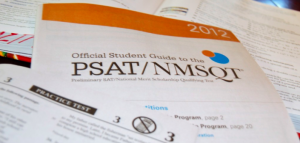 Every October juniors are given the opportunity to take the PSAT/NMSQT. This is essentially a practice round for the real SAT. In fact, PSAT stands for Preliminary SAT (it used to stand for Preliminary Scholastic Aptitude Test inasmuch as the SAT used to stand for Scholastic Aptitude Test). PSAT scores do not count for college admissions.
Every October juniors are given the opportunity to take the PSAT/NMSQT. This is essentially a practice round for the real SAT. In fact, PSAT stands for Preliminary SAT (it used to stand for Preliminary Scholastic Aptitude Test inasmuch as the SAT used to stand for Scholastic Aptitude Test). PSAT scores do not count for college admissions.
So what is the PSAT?
The PSAT is a shortened version of the SAT. Instead of being comprised of 10 sections (like the SAT), the PSAT is only 5 sections long. These sections include two 25-minute math sections, two 25-minute critical reading sections, and one 30-minute grammar section. All of the question types are consistent with the types on the actual SAT. Sophomores or juniors can take the PSAT in mid-October. Public schools generally offer the exam on a Saturday and private schools typically administer the PSAT on a Wednesday. Registration takes place through the guidance office of your high school.
Why should a student take the PSAT?
The most important reason for students to take the PSAT is to see what this test material is like. For most students, their first PSAT will be their first look at SAT questions. Too many people believe that if they do well in school, they will do just fine on the SAT. Because the SAT requires a very different skill-set than school exams, PSAT results often serve as a wake-up call that meaningful preparation will be necessary to achieve a satisfactory score on the SAT. So essentially taking the PSAT can scare students into working hard for the actual SAT.
What do my scores mean?
Each of the 3 sections – critical reading, math, writing skills – have a top score of 80. This means the highest total composite score is 240 (the sum of the 3 sections). These scores are directly comparable to SAT scores by adding on a zero to the end of each score (SAT scores are out of 800 for each section). PSAT scores give students an idea of what they would score on an actual exam, but – I cannot stress this enough – PSAT SCORES DO NOT COUNT FOR COLLEGE ADMISSIONS. Only SAT scores do. Or ACT scores.
What about those other letters – NMSQT?
NMSQT stands for National Merit Scholarship Qualifying Test. The PSAT given in the fall of junior year also serves as a scholarship qualifying test. To be considered for the process of qualifying for a national merit scholarship, students must score in the top 1% in their respective states. This requires a very high score which varies by state. In New York, the required score is usually around 218 which means a student would have to average a 73 out of 80 on each of the 3 parts. Even more than the benefit of a scholarship (which are very nominal when considering the total cost of a college education), becoming a national merit finalist is a tremendous accolade to add to any student’s college applications.
Who should take the PSAT?
If your school allows you to take the PSAT in your sophomore year, go for it! Take advantage of the opportunity to learn very early what the SAT is like. This may help you map out a plan for when you will begin your formal SAT preparations. If you are a junior and you haven’t taken the PSAT yet, then you should definitely take it in October of your junior year (unless you have no intention of take the SAT or going to college, but if that’s the case, you probably won’t be reading this blog).
What if I already took the PSAT as a Sophomore? Should I take it again?
Probably. Students tend to score higher on the PSAT as juniors and a junior year PSAT score may provide a more accurate baseline for your SAT preparations. That being said, if you already took the PSAT in 10th grade and you have a significant personal obligation preventing you from taking it again, it wouldn’t be a huge problem. You probably already know you plan on preparing for the SAT.
This is an overview of some of the basic concepts surrounding the PSAT exam offered each fall. Do you have a question about the PSAT, SAT, or ACT that I haven’t addressed yet? Feel free to reach out. Your question may become a future blog post!


